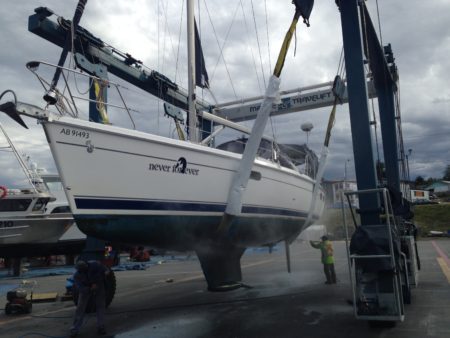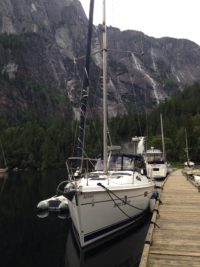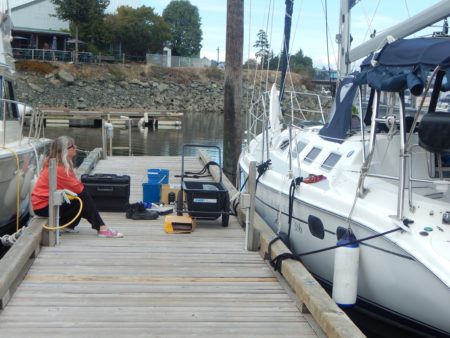Boat Charter Season Update
Well it’s fall and Never for Ever is all prepped for winter. And that means it’s time to take a look at how her first season in charter went. As a bit of a preface for those of you who aren’t familiar with the charter business, or at least aren’t familiar with the charter business in the PNW, let’s review the business model and expectations.
The Charter Biz
The boat charter business consists of a partnership between the owners of boats and the charter company operators. The charter company agrees to market and facilitate their use as charter boats for hire. They also agree to maintain the boats and provide storage, winterization etc. In exchange they take a percentage of the fees charged and also make a profit on any work and maintenance that is done to the boats.
In the PNW, unlike the majority of the rest of the world’s charter business model, a lot of the charter companies actually own some of the boats in their fleets. This can be good and bad I suppose. They might promote their own boats over yours — so I guess not having your boat in direct competition might be good, but it also suggests, at least to me, they have more of a vested interested in the business.
In the Caribbean or other parts of the world where chartering is common, the long charter season means that an owner might potentially make a profit, or at least be able to cover the costs of mortgaging a new boat — there is plenty of arguments online about whether or not this is advisable and I certainly can see a case for not letting every Tom, Dick and Ahab use and abuse your new boat. But here in the waters of the Pacific Northwest, the season is relatively short with only July and August being considered prime earning months with June and September being more of a shoulder season. Therefore the expectation is more one of breaking even, paying the costs of ownership and having someone look after the boat when you are away. And it means there is a room for well maintained, older boats to be placed into charter.
So if you own a fairly popular model, older boat that you wouldn’t mind taking the risk of letting strangers skipper her around the Salish Sea and you can’t use her full time, there are a lot of benefits to considering putting her in charter. A big one for us, since we are 1000+ miles away and in the near future will likely only be sailing on one or two trips a year, is having a boat prepped and ready to go when we arrive. No need to budget a week or more getting her ready. We also receive a minimal discount on work done since Nanaimo Yacht Charters also operates Nanaimo Yacht Services with their own haulout facilities.

Dollars and Sense
But on to the bottom line. Our insurance was costing us about $900/year, moorage was looking to be around $4000 annually. I am going to throw in another $3000 annually for maintenance (although I think that’s conservative). That means our cost of ownership for the 2016-2017 would be at minimum $7900, not counting any work or maintenance we would need to do. The other option we had considered after we finished our year of living aboard,was selling her. In that scenario, assuming we continued to sail at least 2 weeks every year, we would have been looking at an outlay of around $6000/year. So if we intended to keep getting our sailing fix we would be looking at anywhere from $6000 to $10,000 a year if we hadn’t decided to put our boat in charter.
But, after just one short season (we turned the boat over at the end of June), our total bill —covering the period until next June — just arrived at it comes in at around only $900. In our favour. That’s right, we actually made a profit. I couldn’t be happier. And we fully intend at this point to spend up to two months sailing her next year in May and June — that would be a $20,000+ touch if we tried chartering.
But let’s break it down. The numbers are approximate and the list of work done isn’t comprehensive, but it will give you a good idea of what went into a three-month season in charter. It also doesn’t bring things like depreciation or lost income from the money if I had invested it in something else besides a boat.
| Weeks Chartered | Net income |
| 1 | $1500 |
| 1 | $1700 |
| 2 | $3100 |
| 1 | $1700 |
| 2 | $2500 |
| 2 | $2500 |
| Total income | $13000 |
| Annual costs & Work Completed | |
| repair heater | |
| haulout & zincs | |
| spring cleaning | |
| adjust stuffing box | |
| oil change | |
| new head hoses | |
| new macerator | |
| oil change | |
| work on steering | |
| Annual insurance | |
| 12 months Moorage | |
| 12 months Shore power | |
| Total Costs | $12100 |
| Total Income | $13000 |
| Total Costs | $12100 |
| Total Revenue | $900 |
 Conclusions
Conclusions
So at the end of this season, I walk away with around a thousand dollars for the privilege of owning and using a boat on the magnificent west coast of Canada. Of course I need to replace the windlass and have a few more items on the wish list to do so I wont see any profit after all but… And there will likely be a bit more in the way of winterization and spring commissioning costs so maybe it would be more fair to call it even for the whole year. If I was a bit more boat proud or Never for Ever was intended to be my “forever” boat I might be inclined to think that the engine hours and inevitable wear and tear added a significant amount to the actual deficit, but I’m not and it doesn’t really. And since it is an older boat depreciation is much less of a factor than if it was brand new. All I know is that if the domestic situation allows, we will board her again next May and enjoy two months of worry-free sailing and if the luck — and the marketplace — is on our side, next fall I might even walk away with an extra $900 in my pocket instead. And that’s my definition of a good deal.
Update
I just got an email from NYCSS and it turns out they had sold my old spare anchor for me, mistakenly charged me extra GST on my insurance and forgot to bill us for the storage locker we rented. So it turns out rather than $900, they only owe us $600. Still, not too shabby …
Disclaimer: I am a notorious “rounder” of numbers and the most incompetent accountant I know. I actually had to call them to find out if I owed them $900 (like I stated in the original version of this post) or they owed us $900. None of this is intended to provide anymore than a reasonably forthright account of how I view our financial outcomes after our first season. Your mileage, as they say, may vary.



